Application and Development of Smart Thermally Conductive Fiber Materials
Abstract
:1. Introduction
- (1)
- These materials possess a more complex structure and composition. Traditional thermally conductive materials, such as metal plates and ceramics, typically have a homogeneous and continuous structure. However, based on interdisciplinary collaboration and technological advancements in materials science, information technology, biology, and other disciplines, it is possible to prepare green, super-performance, smart thermally conductive fiber materials with multicomponent, multistructured, and multifunctional properties [22]. This enables the integration and optimization of performance by providing a larger surface area and better heat conduction paths. This enhances their λ.
- (2)
- Smart thermally conductive fiber materials exhibit greater plasticity and adaptability. These smart materials can be designed in terms of dimensions, structures, and components to meet diverse environmental and application-specific requirements. Their plasticity and adaptability surpass those of traditional materials, which often have rigid shapes and structures that limit their versatility.
- (3)
- Smart thermally conductive fiber materials possess superior functional characteristics. It is possible to design the fibers to achieve more specific and efficient thermal management functions for different application scenarios. For instance, phase change thermally conductive fibers can absorb and release heat through phase change energy storage, providing temperature regulation and control. Similarly, carbon nanotube thermally conductive fibers, which are known for their higher thermal conductivity, facilitate more efficient heat transfer [23].
- (4)
- Smart thermally conductive fiber materials have a wider range of applications. These materials have broader applications than their traditional counterparts; notably, in clothing and electronic device heat dissipation. For example, Fan et al. developed a new all-weather personal thermal management textile called TAWT, which provides advanced ideas and methods for the development of multifunctional textiles [24].
2. Basic Concept
3. Advanced Thermally Conductive Fiber Materials
3.1. Composite Thermally Conductive Fibers with High Thermal Conductivity Fillers
3.2. Thermally Conductive Fiber Materials for Electric Heating
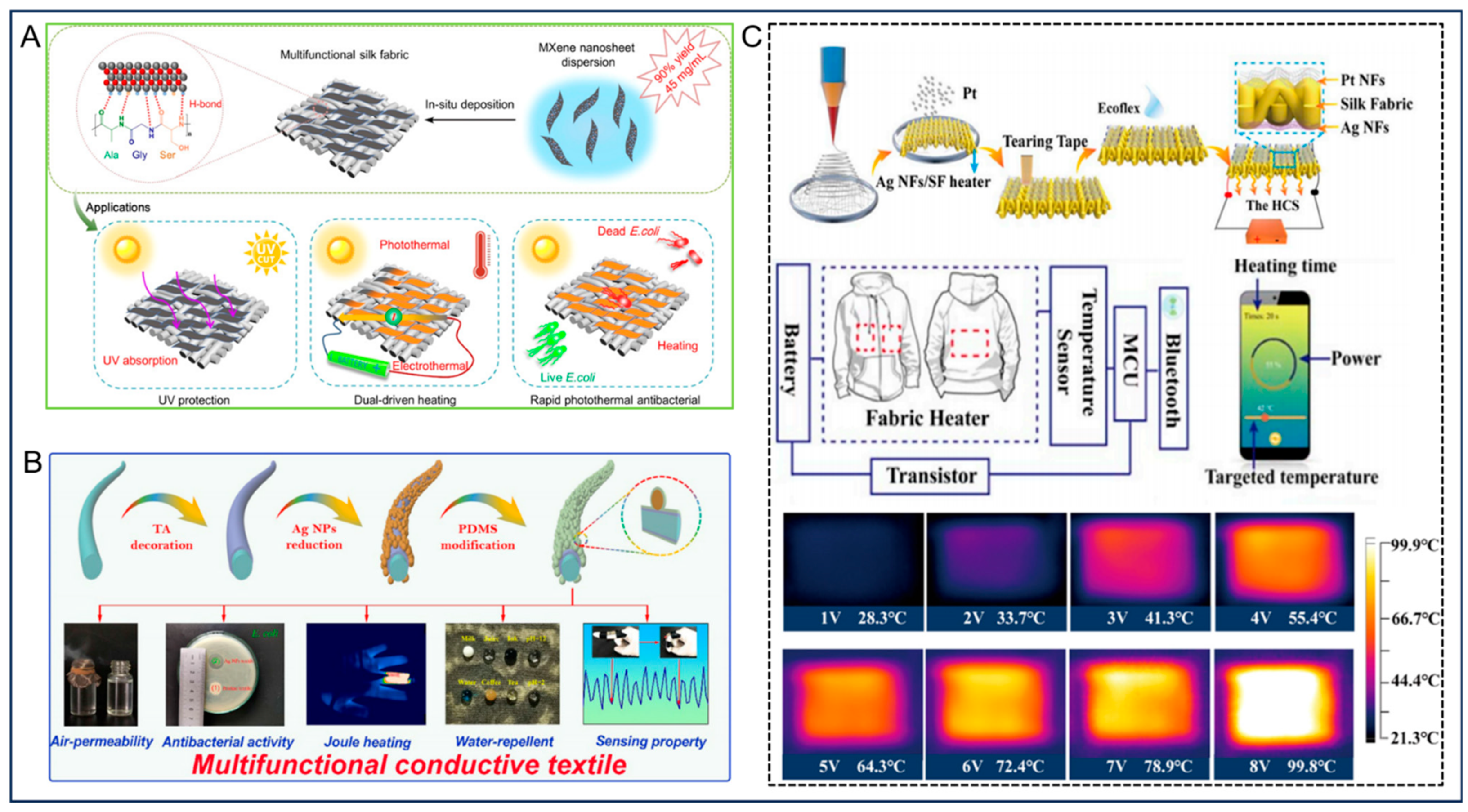
3.3. Thermal Radiation Conductive Fiber Materials

3.4. PCM Thermally Conductive Fiber Materials
4. Summary and Outlook
- (1)
- (2)
- The manufacturing process of thermal management fibers combining advanced materials is complex and costly; this prevents them from being widely available on a large scale.
- (3)
- Ensuring the long-term stability and durability of smart thermally conductive fiber materials is crucial. This includes maintaining their thermal conductivity properties even after repeated use and exposure to various environmental conditions.
- (4)
- There is a need for a comprehensive integrated evaluation system to evaluate the thermal management capabilities of smart thermally conductive fiber materials effectively.
- (5)
- Requirements with respect to the temperature threshold of phase change materials are often very stringent, and the transition point of many materials considerably deviates from room temperature, restricting their application scope.
- (6)
- Smart thermally conductive fiber materials should be compatible and easily integrated into existing products and systems, such as clothing, bedding, and electronic devices. This requires consideration of factors such as compatibility with various fabrication techniques and resilience to mechanical stresses.
- (7)
- The regulation mechanism of smart thermally conductive fiber materials still needs to be studied in depth; this includes their thermal conductivity under different microstructures.
- (8)
- The materials must meet safety standards and ensure user comfort, encompassing biocompatibility, non-toxicity, breathability, and flexibility for a comfortable and safe user experience.
- (9)
- Considering the growing concern for environmental sustainability, it is essential to assess the environmental impact of these materials throughout their lifecycle, from production to disposal. Developing eco-friendly alternatives and recycling methods is crucial for sustainable practices.
Author Contributions
Funding
Data Availability Statement
Conflicts of Interest
References
- Sun, B.; Huang, X. Seeking advanced thermal management for stretchable electronics. NPJ Flex. Electron. 2021, 5, 12. [Google Scholar] [CrossRef]
- Yan, Q.; Alam, F.E.; Gao, J. Soft and self-adhesive thermal interface materials based on vertically aligned, covalently bonded graphene nanowalls for efficient microelectronic cooling. Adv. Funct. Mater. 2021, 31, 2104062. [Google Scholar] [CrossRef]
- Gong, J.; Tan, X.; Yuan, Q. A Spiral Graphene Framework Containing Highly Ordered Graphene Microtubes for Polym. Compos. with Superior Through-Plane Thermal Conductivity. Chin. J. Chem. 2022, 40, 329–336. [Google Scholar] [CrossRef]
- Lin, M.; Zheng, Z.; Yang, L.; Luo, M.; Fu, L.; Lin, B.; Xu, C. A high-performance, sensitive, wearable multifunctional sensor based on rubber/CNT for human motion and skin temperature detection. Adv. Mater. 2022, 34, 2107309. [Google Scholar] [CrossRef] [PubMed]
- Lin, Y.; Kang, Q.; Wei, H. Spider web-inspired graphene skeleton-based high thermal conductivity phase change nanocomposites for battery thermal management. Nano-Micro Lett. 2021, 13, 180. [Google Scholar] [CrossRef] [PubMed]
- Ling, Z.; Zhang, Z.; Shi, G. Review on thermal management systems using phase change materials for electronic components, Li-ion batteries and photovoltaic modules. Renew. Sustain. Energy Rev. 2014, 31, 427–438. [Google Scholar] [CrossRef]
- Wu, S.; Li, T.; Tong, Z. High-performance thermally conductive phase change composites by large-size oriented graphite sheets for scalable thermal energy harvesting. Adv. Mater. 2019, 31, 1905099. [Google Scholar] [CrossRef]
- Yan, Q.; Dai, W.; Gao, J. Ultrahigh-aspect-ratio boron nitride nanosheets leading to superhigh in-plane thermal conductivity of foldable heat spreader. ACS Nano 2021, 15, 6489–6498. [Google Scholar] [CrossRef]
- Lin, Y.; Chen, J.; Dong, S. Wet-resilient graphene aerogel for thermal conductivity enhancement in polymer nanocomposites. J. Mater. Sci. Technol. 2021, 83, 219–227. [Google Scholar] [CrossRef]
- Wen, Y.; Chen, C.; Ye, Y.; Xue, Z.; Liu, H.; Zhou, X.; Zhang, Y.; Li, D.; Xie, X.; Mai, Y.W. Advances on thermally conductive epoxy-based composites as electronic packaging underfill materials-a review. Adv. Mater. 2022, 1, 2201023. [Google Scholar] [CrossRef]
- Hu, R.; Liu, Y.; Shin, S. Emerging materials and strategies for personal thermal management. Adv. Energy Mater. 2020, 10, 1903921. [Google Scholar] [CrossRef]
- Min, P.; Liu, J.; Li, X. Thermally conductive phase change composites featuring anisotropic graphene aerogels for real-time and fast-charging solar-thermal energy conversion. Adv. Funct. Mater. 2018, 28, 1805365. [Google Scholar] [CrossRef]
- Yu, H.; Guo, P.; Qin, M. Highly thermally conductive polymer composite enhanced by two-level adjustable boron nitride network with leaf venation structure. Compos. Sci. Technol. 2022, 222, 109406. [Google Scholar] [CrossRef]
- Wang, B.; Li, G.; Xu, L. Nanoporous boron nitride aerogel film and its smart composite with phase change materials. ACS Nano 2020, 14, 16590–16599. [Google Scholar] [CrossRef] [PubMed]
- Li, Y.; Huang, X. Graphene-CoO/PEG composite phase change materials with enhanced solar-to-thermal energy conversion and storage capacity. Compos. Sci. Technol. 2020, 195, 108197. [Google Scholar] [CrossRef]
- Zhu, Y.; Shen, Z.; Li, Y. High conduction band inorganic layers for distinct enhancement of electrical energy storage in polymer nanocomposites. Nano-Micro Lett. 2022, 14, 151. [Google Scholar] [CrossRef] [PubMed]
- Huang, L.; Wang, Y. Self-exfoliation of flake graphite for bioinspired compositing with aramid nanofiber toward integration of mechanical and thermoconductive properties. Nano-Micro Lett. 2022, 14, 168. [Google Scholar] [CrossRef]
- Yu, H.; Feng, Y.; Chen, C. Highly thermally conductive adhesion elastomer enhanced by vertically aligned folded graphene. Adv. Sci. 2022, 9, 2201331. [Google Scholar] [CrossRef] [PubMed]
- Chen, J.; Shen, Z.; Kang, Q. Chemical adsorption on 2D dielectric nanosheets for matrix free nanocomposites with ultrahigh electrical energy storage. Sci. Bull. 2022, 67, 609–618. [Google Scholar] [CrossRef]
- Chen, H.; Ginzburg, V.V.; Yang, J. Thermal conductivity of polymer-based composites: Fundamentals and applications. Prog. Polym. Sci. 2016, 59, 41–85. [Google Scholar] [CrossRef]
- Burger, N.; Laachachi, A.; Ferriol, M. Review of thermal conductivity in composites: Mechanisms, parameters and theory. Prog. Polym. Sci. 2016, 61, 1–28. [Google Scholar] [CrossRef]
- Gao, T.; Yang, Z.; Chen, C. Three-dimensional printed thermal regulation textiles. ACS Nano 2017, 11, 11513–11520. [Google Scholar] [CrossRef] [PubMed]
- Cai, Y.; Qin, M.M.; Feng, W. Carbon Nanotube Arrays with Cross-Linked Networks for Thermal Conductivity. J. Funct. Polym. 2022, 35, 524–531. [Google Scholar]
- Yan, Z.; Zhai, H.; Fan, D. A trimode textile designed with hierarchical core-shell nanofiber structure for all-weather radiative personal thermal management. Nano Today 2023, 51, 101897. [Google Scholar] [CrossRef]
- Mortazavi, S.M.; Kamali, M.M. An analysis of structure and properties of a natural cellulosic fiber. Fibers Polym. 2010, 11, 877–882. [Google Scholar] [CrossRef]
- Yu, W.D. Textile Materials, 1st ed.; China Textile University Press: Shanghai, China, 2006; pp. 140–143. [Google Scholar]
- Cosma, A.C.; Simha, R. Using the contrast within a single face heat map to assess personal thermal comfort. Build. Environ. 2019, 160, 106163. [Google Scholar] [CrossRef]
- Lin, Z.; Deng, S. A study on the thermal comfort in sleeping environments in the subtropics—Developing a thermal comfort model for sleeping environments. Build. Environ. 2008, 43, 70–81. [Google Scholar] [CrossRef]
- Chan, A.P.C.; Yi, W. Heat stress and its impacts on occupational health and performance. Indoor Built Environ. 2016, 25, 3–5. [Google Scholar] [CrossRef]
- Guo, Y.; Dun, C.; Xu, J. Ultrathin, Washable, and Large-Area Graphene Papers for Personal Thermal Management. Small 2017, 13, 1702645. [Google Scholar] [CrossRef]
- Hsu, P.C.; Liu, X.; Liu, C. Personal thermal management by metallic nanowire-coated textile. Nano Lett. 2015, 15, 365–371. [Google Scholar] [CrossRef]
- Wang, L.; Fu, X.; He, J. Application challenges in fiber and textile electronics. Adv. Mater. 2020, 32, 1901971. [Google Scholar] [CrossRef] [PubMed]
- Shi, J.; Liu, S.; Zhang, L. Smart textile-integrated microelectronic systems for wearable applications. Adv. Mater. 2020, 32, 1901958. [Google Scholar] [CrossRef] [PubMed]
- Wang, Y.; Yang, L.; Shi, X.L. Flexible thermoelectric materials and generators: Challenges and innovations. Adv. Mater. 2019, 31, 1807916. [Google Scholar] [CrossRef] [PubMed]
- Huang, L.; Lin, S.; Xu, Z. Fiber-based energy conversion devices for human-body energy harvesting. Adv. Mater. 2020, 32, 1902034. [Google Scholar] [CrossRef] [PubMed]
- Zeng, W.; Shu, L.; Li, Q. Fiber-based wearable electronics: A review of materials, fabrication, devices, and applications. Adv. Mater. 2014, 26, 5310–5336. [Google Scholar] [CrossRef] [PubMed]
- Chen, S.; Feng, Y.; Qin, M. Improving thermal conductivity in the through-thickness direction of carbon fibre/SiC composites by growing vertically aligned carbon nanotubes. Carbon 2017, 116, 84–93. [Google Scholar] [CrossRef]
- Sun, Z.; Fang, S.; Hu, Y.H. 3D graphene materials: From understanding to design and synthesis control. Chem. Rev. 2020, 120, 10336–10453. [Google Scholar] [CrossRef]
- Ni, Y.; Yang, D.; Hu, T. Fabrication of natural rubber dielectric elastomers with enhanced thermal conductivity via dopamine chemistry. Compos. Commun. 2019, 16, 132–135. [Google Scholar] [CrossRef]
- Mateti, S.; Yang, K.; Liu, X. Bulk hexagonal boron nitride with a quasi-isotropic thermal conductivity. Adv. Funct. Mater. 2018, 28, 1707556. [Google Scholar] [CrossRef]
- Kang, D.G.; Kim, N.; Park, M. Interfacial engineering for the synergistic enhancement of thermal conductivity of discotic liquid crystal composites. ACS Appl. Mater. Interfaces 2018, 10, 3155–3159. [Google Scholar] [CrossRef]
- Li, K.; Chang, T.H.; Li, Z. Light-to-Heat Conversion: Biomimetic MXene Textures with Enhanced Light-to-Heat Conversion for Solar Steam Generation and Wearable Thermal Management. Adv. Energy Mater. 2019, 9, 1970141. [Google Scholar] [CrossRef]
- Yu, X.; Li, Y.; Wang, X. Thermoconductive, moisture-permeable, and superhydrophobic nanofibrous membranes with interpenetrated boron nitride network for personal cooling textiles. ACS Appl. Mater. Interfaces 2020, 12, 32078–32089. [Google Scholar] [CrossRef] [PubMed]
- Yin, J.; Li, J.; Hang, Y. Boron nitride nanostructures: Fabrication, functionalization and applications. Small 2016, 12, 2942–2968. [Google Scholar] [CrossRef] [PubMed]
- Guerra, V.; Wan, C.; McNally, T. Thermal conductivity of 2D nano-structured boron nitride (BN) and its composites with polymers. Prog. Mater. Sci. 2019, 100, 170–186. [Google Scholar] [CrossRef]
- Zhang, Z.; Mogurampelly, S.; Percec, S. Mechanically strong polymer sheets from aligned ultrahigh-molecular-weight polyethylene nanocomposites. J. Phys. Chem. Lett. 2018, 9, 2652–2658. [Google Scholar] [CrossRef] [PubMed]
- Xu, C.; Miao, M.; Jiang, X. Thermal conductive composites reinforced via advanced boron nitride nanomaterials. Compos. Commun. 2018, 10, 103–109. [Google Scholar] [CrossRef]
- Tao, Y.; Li, T.; Yang, C. The influence of fiber cross-section on fabric far-infrared properties. Polymers 2018, 10, 1147. [Google Scholar] [CrossRef]
- Jafar, Z.S.; Salary, M.M.; Mosallaei, H. Metatextiles for thermoregulation and energy-harvesting applications. ACS Photonics 2017, 4, 915–927. [Google Scholar] [CrossRef]
- Wu, K.; Yu, L.; Lei, C. Green production of regenerated cellulose/boron nitride nanosheet textiles for static and dynamic personal cooling. ACS Appl. Mater. Interfaces 2019, 11, 40685–40693. [Google Scholar] [CrossRef]
- Wu, L.; Wu, K.; Lei, C. Surface modifications of boron nitride nanosheets for poly (vinylidene fluoride) based film capacitors: Advantages of edge-hydroxylation. J. Mater. Chem. A 2019, 7, 7664–7674. [Google Scholar] [CrossRef]
- Wu, K.; Liao, P.; Du, R. Preparation of a thermally conductive biodegradable cellulose nanofiber/hydroxylated boron nitride nanosheet film: The critical role of edge-hydroxylation. J. Mater. Chem. A 2018, 6, 11863–11873. [Google Scholar] [CrossRef]
- Wei, Z.; Gong, P.; Kong, X. Enhanced Thermal Conductivity of Nanodiamond Nanosheets/Polymer Nanofiber Composite Films by Uniaxial and Coaxial Electrospinning: Implications for Thermal Management of Nanodevices. ACS Appl. Nano Mater. 2023, 6, 8358–8366. [Google Scholar] [CrossRef]
- Jiang, Y.; Li, C.; Jiang, P. Preparation and characterization of viscose composites fiber and its enhancing effect in photothermal conversion property. Polym. Compos. 2020, 41, 4084–4092. [Google Scholar] [CrossRef]
- Maity, S. Optimization of processing parameters of in-situ polymerization of pyrrole on woollen textile to improve its thermal conductivity. Prog. Org. Coat. 2017, 107, 48–53. [Google Scholar] [CrossRef]
- Abbas, A.; Zhao, Y.; Wang, X. Cooling effect of MWCNT-containing composite coatings on cotton textiles. J. Text. Inst. 2013, 104, 798–807. [Google Scholar] [CrossRef]
- Montazer, M.; Ghayem, A.M.S.; Pakdel, E. Electrical conductivity of single walled and multiwalled carbon nanotube containing wool fibers. J. Appl. Polym. Sci. 2011, 121, 3353–3358. [Google Scholar] [CrossRef]
- Manasoglu, G.; Celen, R.; Kanik, M. Electrical resistivity and thermal conductivity properties of graphene-coated woven textiles. J. Appl. Polym. Sci. 2019, 136, 48024. [Google Scholar] [CrossRef]
- Chen, H.; Ding, Y.; Zhu, G. A new route to fabricate flexible, breathable composites with advanced thermal management capability for wearable electronics. NPJ Flex. Electron. 2023, 7, 24. [Google Scholar] [CrossRef]
- Liu, X.; Li, L. Air-permeable, multifunctional, dual-energy-driven MXene-decorated polymeric textile-based wearable heaters with exceptional electrothermal and photothermal conversion performance. J. Mater. Chem. A 2020, 8, 12526–12537. [Google Scholar] [CrossRef]
- Li, Y.; Zhu, H.; Wang, Y. Cellulose-nanofiber-enabled 3D printing of a carbon-nanotube microfiber network. Small Methods 2017, 1, 1700222. [Google Scholar] [CrossRef]
- Huang, J.; Li, Y.; Xu, Z. An integrated smart heating control system based on sandwich-structural textiles. Nanotechnology 2019, 30, 325203. [Google Scholar] [CrossRef] [PubMed]
- Won, P.; Park, J.J.; Lee, T. Stretchable and transparent kirigami conductor of nanowire percolation network for electronic skin applications. Nano Lett. 2019, 19, 6087–6096. [Google Scholar] [CrossRef] [PubMed]
- Hao, D.; Xu, B.; Cai, Z. Polypyrrole coated knitted fabric for robust wearable sensor and heater. J. Mater. Sci. Mater. Electron. 2018, 29, 9218–9226. [Google Scholar] [CrossRef]
- Petru, M.; Ali, A.; Khan, A.S. Flexible Coated Conductive Textiles as Ohmic Heaters in Car Seats. Appl. Sci. 2023, 13, 6874. [Google Scholar] [CrossRef]
- Yan, B.; Zhou, M.; Liao, X. Developing a multifunctional silk fabric with dual-driven heating and rapid photothermal antibacterial abilities using high-yield MXene dispersions. ACS Appl. Mater. Interfaces 2021, 13, 43414–43425. [Google Scholar] [CrossRef]
- Ahmed, A.; Jalil, M.A.; Hossain, M.M. A PEDOT: PSS and graphene-clad smart textile-based wearable electronic Joule heater with high thermal stability. J. Mater. Chem. C 2020, 8, 16204–16215. [Google Scholar] [CrossRef]
- Bu, Y.; Zhang, S.; Cai, Y. Fabrication of durable antibacterial and superhydrophobic textiles via in situ synthesis of silver nanoparticle on tannic acid-coated viscose textiles. Cellulose 2019, 26, 2109–2122. [Google Scholar] [CrossRef]
- Guo, Z.; Wang, Y.; Huang, J. Multi-functional and water-resistant conductive silver nanoparticle-decorated cotton textiles with excellent joule heating performances and human motion monitoring. Cellulose 2021, 28, 7483–7495. [Google Scholar] [CrossRef]
- Korzeniewska, E.; Duraj, A.; Krawczyk, A. Analysis of thermographic images of thin metal layers using grouping algorithms. Prz. Elektrotech. 2016, 92, 73–76. [Google Scholar] [CrossRef]
- Pawlak, R.; Lebioda, M. Electrical and thermal properties of heater-sensor microsystems patterned in TCO films for wide-range temperature applications from 15 K to 350 K. Sensors 2018, 18, 1831. [Google Scholar] [CrossRef]
- Zhang, X.A.; Yu, S.; Xu, B. Dynamic gating of infrared radiation in a textile. Science 2019, 363, 619–623. [Google Scholar] [CrossRef]
- Hardy, J.D.; DuBois, E.F. Regulation of heat loss from the human body. Proc. Natl. Acad. Sci. USA 1937, 23, 624–631. [Google Scholar] [CrossRef] [PubMed]
- Chen, Z.; Zhu, L.; Raman, A. Radiative cooling to deep sub-freezing temperatures through a 24-h day–night cycle. Nat. Commun. 2016, 7, 13729. [Google Scholar] [CrossRef] [PubMed]
- Li, N.; Wang, J.; Liu, D. Selective spectral optical properties and structure of aluminum phosphate for daytime passive radiative cooling application. Sol. Energy Mater. Sol. Cells 2019, 194, 103–110. [Google Scholar] [CrossRef]
- Rephaeli, E.; Raman, A.; Fan, S. Ultrabroadband photonic structures to achieve high-performance daytime radiative cooling. Nano Lett. 2013, 13, 1457–1461. [Google Scholar] [CrossRef]
- Zhang, X. Metamaterials for perpetual cooling at large scales. Science 2017, 355, 1023–1024. [Google Scholar] [CrossRef]
- Zhai, H.; Fan, D.; Li, Q. Dynamic radiation regulations for thermal comfort. Nano Energy 2022, 100, 107435. [Google Scholar] [CrossRef]
- Yao, P.; Chen, Z.; Liu, T. Spider-Silk-Inspired Nanocomposite Polymers for Durable Daytime Radiative Cooling. Adv. Mater. 2022, 34, 2208236. [Google Scholar] [CrossRef]
- Chai, J.; Fan, J. Solar and Thermal Radiation-Modulation Materials for Building Applications. Adv. Energy Mater. 2023, 13, 2202932. [Google Scholar] [CrossRef]
- Liu, J.; Zhang, Y.; Li, S. Emerging materials and engineering strategies for performance advance of radiative sky cooling technology. Chem. Eng. J. 2023, 453, 139739. [Google Scholar] [CrossRef]
- Zeng, S.; Pian, S.; Su, M. Hierarchical-morphology metafabric for scalable passive daytime radiative cooling. Science 2021, 373, 692–696. [Google Scholar] [CrossRef] [PubMed]
- Farooq, A.S.; Zhang, P. Fundamentals, materials and strategies for personal thermal management by next-generation textiles. Compos. Part A Appl. Sci. Manuf. 2021, 142, 106249. [Google Scholar] [CrossRef]
- Song, Y.N.; Lei, M.Q.; Deng, L.F. Hybrid metamaterial textiles for passive personal cooling indoors and outdoors. ACS Appl. Polym. Mater. 2020, 2, 4379–4386. [Google Scholar] [CrossRef]
- Wei, W.; Zhu, Y.; Li, Q. An Al2O3-cellulose acetate-coated textile for human body cooling. Sol. Energy Mater. Sol. Cells 2020, 211, 110525. [Google Scholar] [CrossRef]
- Peng, Y.; Chen, J.; Song, A.Y. Nanoporous polyethylene microfibres for large-scale radiative cooling fabric. Nat. Sustain. 2018, 1, 105–112. [Google Scholar] [CrossRef]
- Song, Y.N.; Lei, M.Q.; Lei, J. Spectrally selective polyvinylidene fluoride textile for passive human body cooling. Mater. Today Energy 2020, 18, 100504. [Google Scholar] [CrossRef]
- Hrubesh, L.W. Aerogel applications. J. Non-Cryst. Solids 1998, 225, 335–342. [Google Scholar] [CrossRef]
- Liu, Z.; Lyu, J.; Fang, D. Nanofibrous kevlar aerogel threads for thermal insulation in harsh environments. ACS Nano 2019, 13, 5703–5711. [Google Scholar] [CrossRef]
- Cui, Y.; Gong, H.; Wang, Y. A thermally insulating textile inspired by polar bear hair. Adv. Mater. 2018, 30, 1706807. [Google Scholar] [CrossRef]
- Yang, J.; Zhou, Y.C.; Yang, L.Y. Exploring Next-Generation Functional Organic Phase Change Composites. Adv. Funct. Mater. 2022, 32, 2200792. [Google Scholar] [CrossRef]
- Zhang, X.; Liu, H.; Huang, Z. Preparation and characterization of the properties of polyethylene glycol@Si3N4 nanowires as phase-change materials. Chem. Eng. J. 2016, 301, 229–237. [Google Scholar] [CrossRef]
- Mondal, S. Phase change materials for smart textiles–An overview. Appl. Therm. Eng. 2008, 28, 1536–1550. [Google Scholar] [CrossRef]
- Iqbal, K.; Khan, A.; Sun, D. Phase change materials, their synthesis and application in textiles—A review. J. Text. Inst. 2019, 110, 625–638. [Google Scholar] [CrossRef]
- Li, G.; Hong, G.; Dong, D. Multiresponsive graphene-aerogel-directed phase-change smart fibers. Adv. Mater. 2018, 30, 1801754. [Google Scholar] [CrossRef] [PubMed]
- Kou, Y.; Sun, K.; Luo, J. An intrinsically flexible phase change film for wearable thermal managements. Energy Storage Mater. 2021, 34, 508–514. [Google Scholar] [CrossRef]
- Koric, S.; Abueidda, D.W. Data-driven and physics-informed deep learning operators for solution of heat conduction equation with parametric heat source. Int. J. Heat Mass Transf. 2023, 203, 123809. [Google Scholar] [CrossRef]
- Wang, J.; Huang, X.; Gao, H. Construction of CNT@Cr-MIL-101-NH2 hybrid composite for shape-stabilized phase change materials with enhanced thermal conductivity. Chem. Eng. J. 2018, 350, 164–172. [Google Scholar] [CrossRef]
- Sánchez, P.; Sánchez-Fernandez, M.V.; Romero, A. Development of thermo-regulating textiles using paraffin wax microcapsules. Thermochim. Acta 2010, 498, 16–21. [Google Scholar] [CrossRef]
- Hassabo, A.G.; Mohamed, A.L. Enhancement the thermo-regulating property of cellulosic fabric using encapsulated paraffins in modified pectin. Carbohydr. Polym. 2017, 165, 421–428. [Google Scholar] [CrossRef]
- Bühler, M.; Popa, A.M.; Scherer, L.J. Heat protection by different phase change materials. Appl. Therm. Eng. 2013, 54, 359–364. [Google Scholar] [CrossRef]
- Lu, Y.; Zhan, Y. View Correspondence, Core-Sheath Paraffin-Wax-Loaded Nanofibers by Electrospinning for Heat Storage. ACS Appl. Mater. Interfaces. 2018, 10, 12759–12767. [Google Scholar] [CrossRef] [PubMed]
- Hu, W.; Yu, X. Encapsulation of bio-based PCM with coaxial electrospun ultrafine fibers. RSC Adv. 2012, 2, 5580–5584. [Google Scholar] [CrossRef]
- Lu, Y.; Fu, J. Novel smart textile with phase change materials encapsulated core-sheath structure fabricated by coaxial electrospinning. Chem. Eng. J. 2019, 355, 532–539. [Google Scholar] [CrossRef]
- Lin, Y.; Kang, Q.; Liu, Y. Flexible, highly thermally conductive and electrically insulating phase change materials for advanced thermal management of 5G base stations and thermoelectric generators. Nano-Micro Lett. 2023, 15, 31. [Google Scholar] [CrossRef]
- Yao, J.; Wang, K.; Ren, M. Phase inversion spinning of ultrafine hollow fiber membranes through a single orifice spinneret. J. Membr. Sci. 2012, 421, 8–14. [Google Scholar] [CrossRef]
- Hu, L.; Li, X.; Ding, L. Flexible textiles with polypyrrole deposited phase change microcapsules for efficient photothermal energy conversion and storage. Sol. Energy Mater. Sol. Cells 2021, 224, 110985. [Google Scholar] [CrossRef]
- Karaszewska, A.; Kamińska, I.; Nejman, A. Thermal-regulation of nonwoven textiles by microcapsules of n-eicosane coated with a polysiloxane elastomer. Mater. Chem. Phys. 2019, 226, 204–213. [Google Scholar] [CrossRef]
- Ahn, J.; Lim, T.; Yeo, C.S. Infrared invisibility cloak based on polyurethane–tin oxide composite microtubes. ACS Appl. Mater. Interfaces 2019, 11, 14296–14304. [Google Scholar] [CrossRef]
- Chen, J.; Huang, X.; Sun, B. Highly thermally conductive yet electrically insulating polymer/boron nitride nanosheets nanocomposite films for improved thermal management capability. ACS Nano 2018, 13, 337–345. [Google Scholar] [CrossRef]
- Guo, Y.; Qiu, H.; Ruan, K. Hierarchically multifunctional polyimide composite films with strongly enhanced thermal conductivity. Nano-Micro Lett. 2022, 14, 26. [Google Scholar] [CrossRef]
- Zhang, F.; Feng, Y.; Qin, M. Stress controllability in thermal and electrical conductivity of 3D elastic graphene-crosslinked carbon nanotube sponge/polyimide nanocomposite. Adv. Funct. Mater. 2019, 29, 1901383. [Google Scholar] [CrossRef]
- Cai, Q.; Scullion, D.; Gan, W. High thermal conductivity of high-quality monolayer boron nitride and its thermal expansion. Sci. Adv. 2019, 5, eaav0129. [Google Scholar] [CrossRef] [PubMed]
- Hong, H.; Jung, Y.H.; Lee, J.S. Anisotropic thermal conductive composite by the guided assembly of boron nitride nanosheets for flexible and stretchable electronics. Adv. Funct. Mater. 2019, 29, 1902575. [Google Scholar] [CrossRef]
- Van, E.R.; Soleimanzadeh, R.; Nela, L. Co-designing electronics with microfluidics for more sustainable cooling. Nature 2020, 585, 211–216. [Google Scholar]
- Ma, Z.; Huang, Q.; Xu, Q. Permeable superelastic liquid-metal fibre mat enables biocompatible and monolithic stretchable electronics. Nat. Mater. 2021, 20, 859–868. [Google Scholar] [CrossRef]
- Miyamoto, A.; Lee, S.; Cooray, N.F. Inflammation-free, gas-permeable, lightweight, stretchable on-skin electronics with nanomeshes. Nat. Nanotechnol. 2017, 12, 907–913. [Google Scholar] [CrossRef]
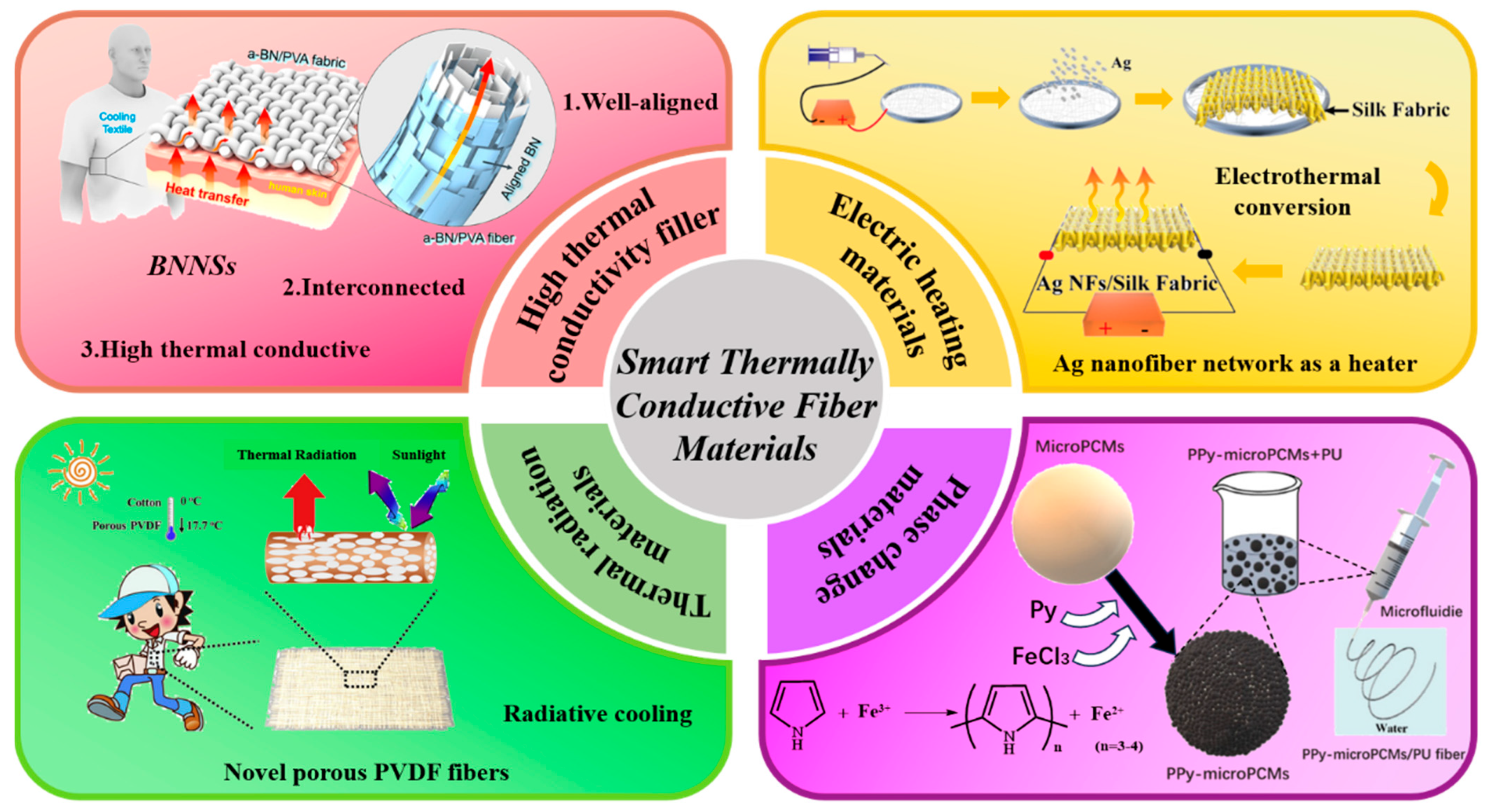

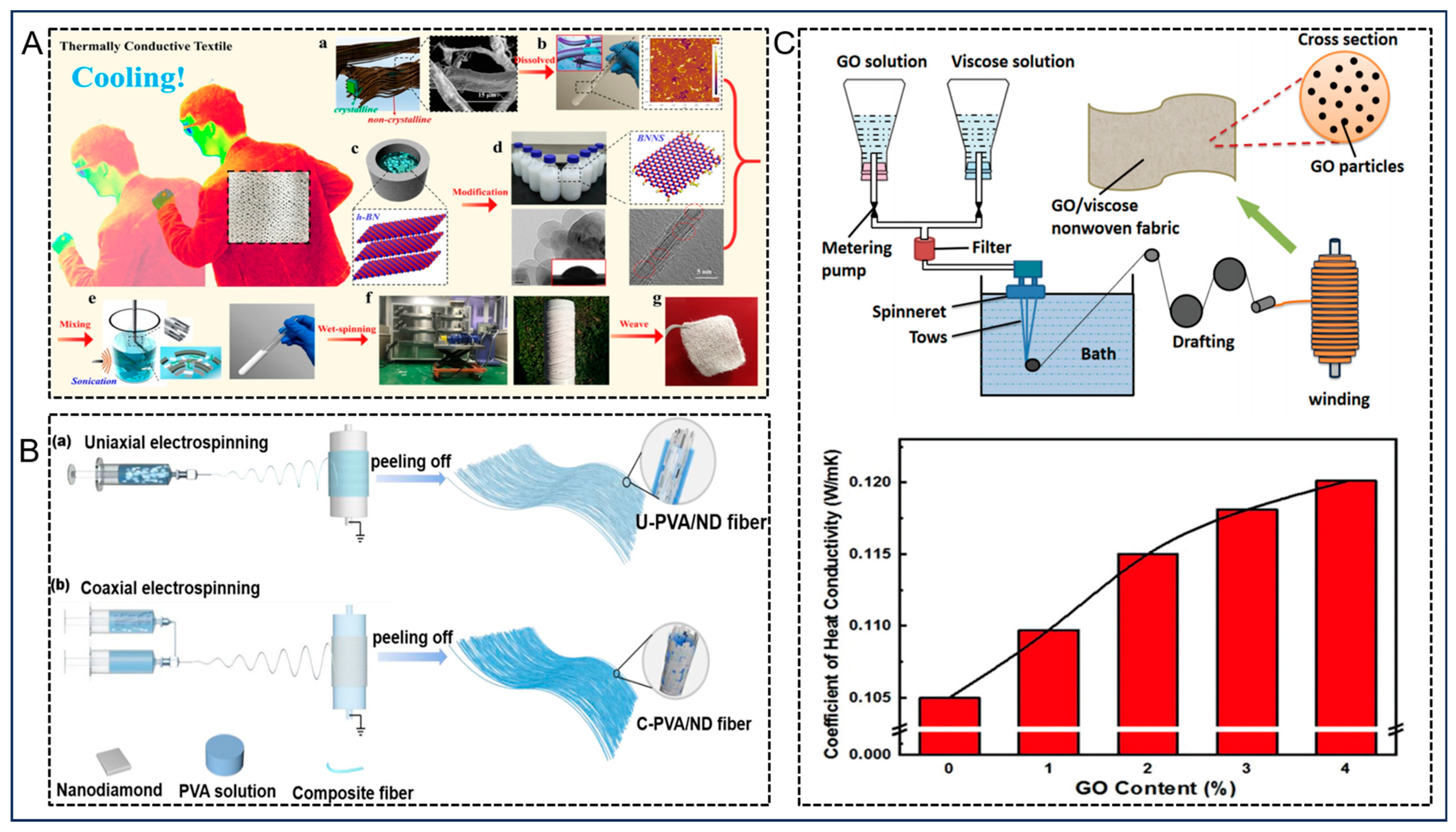
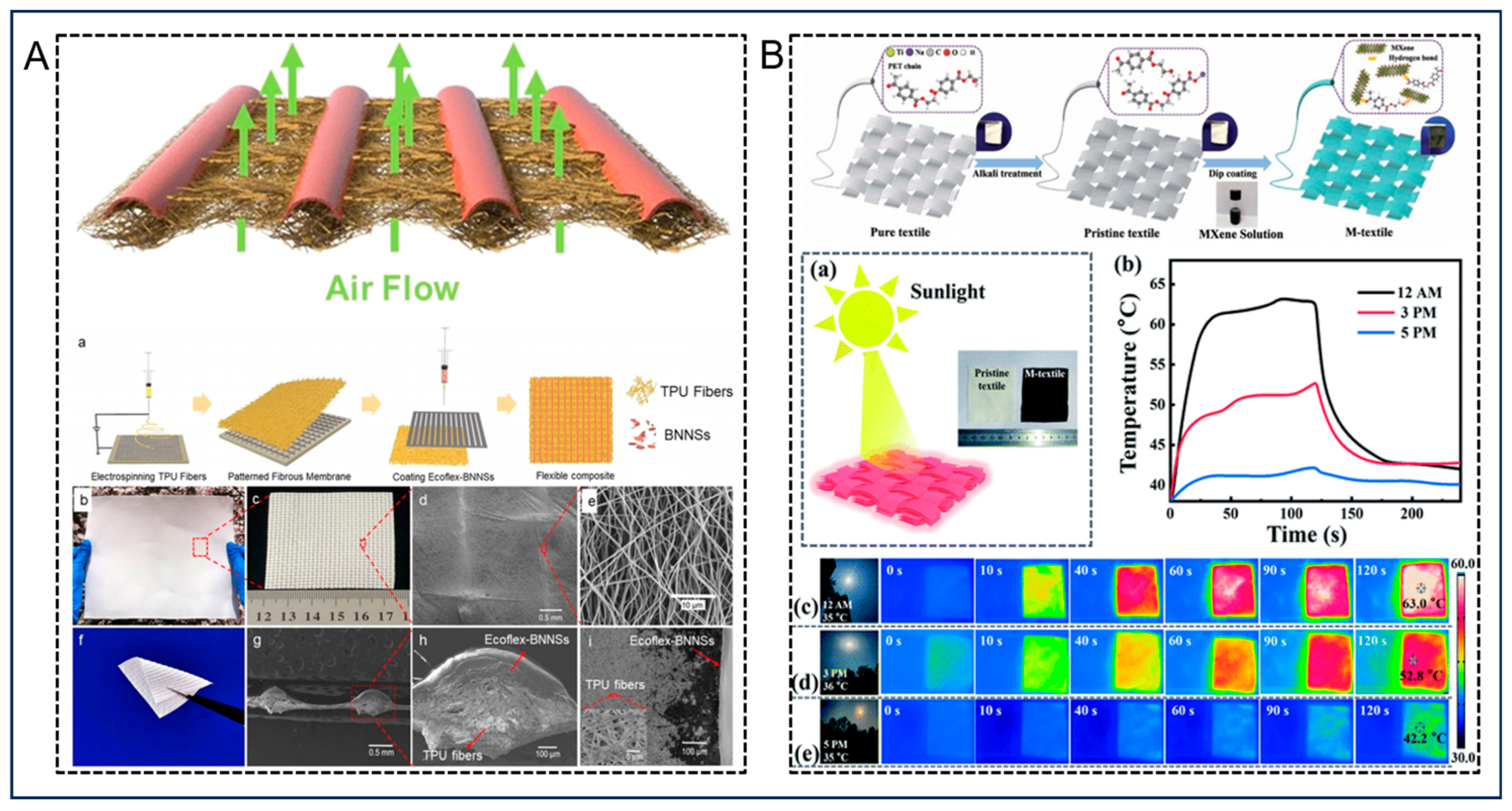
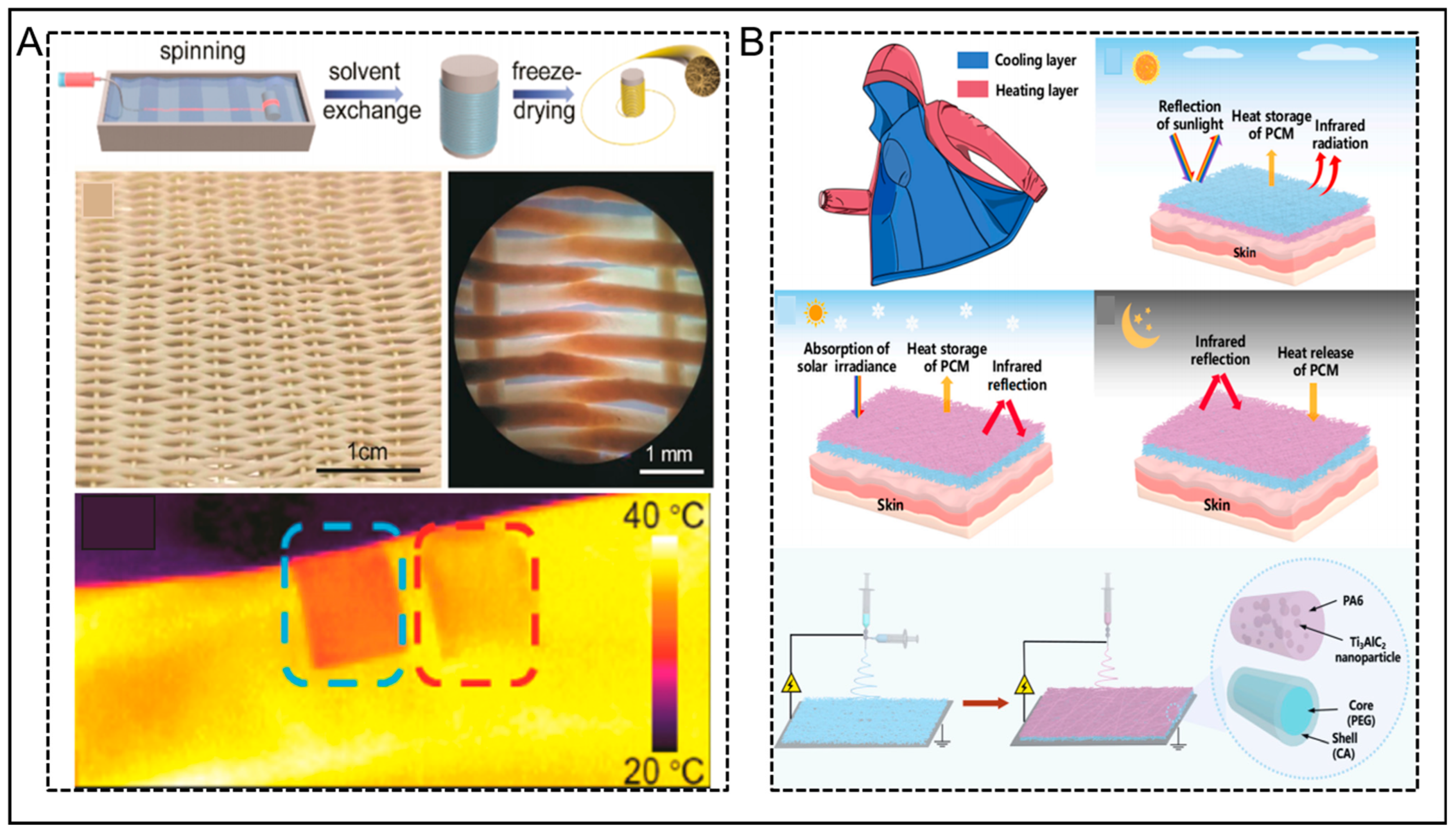
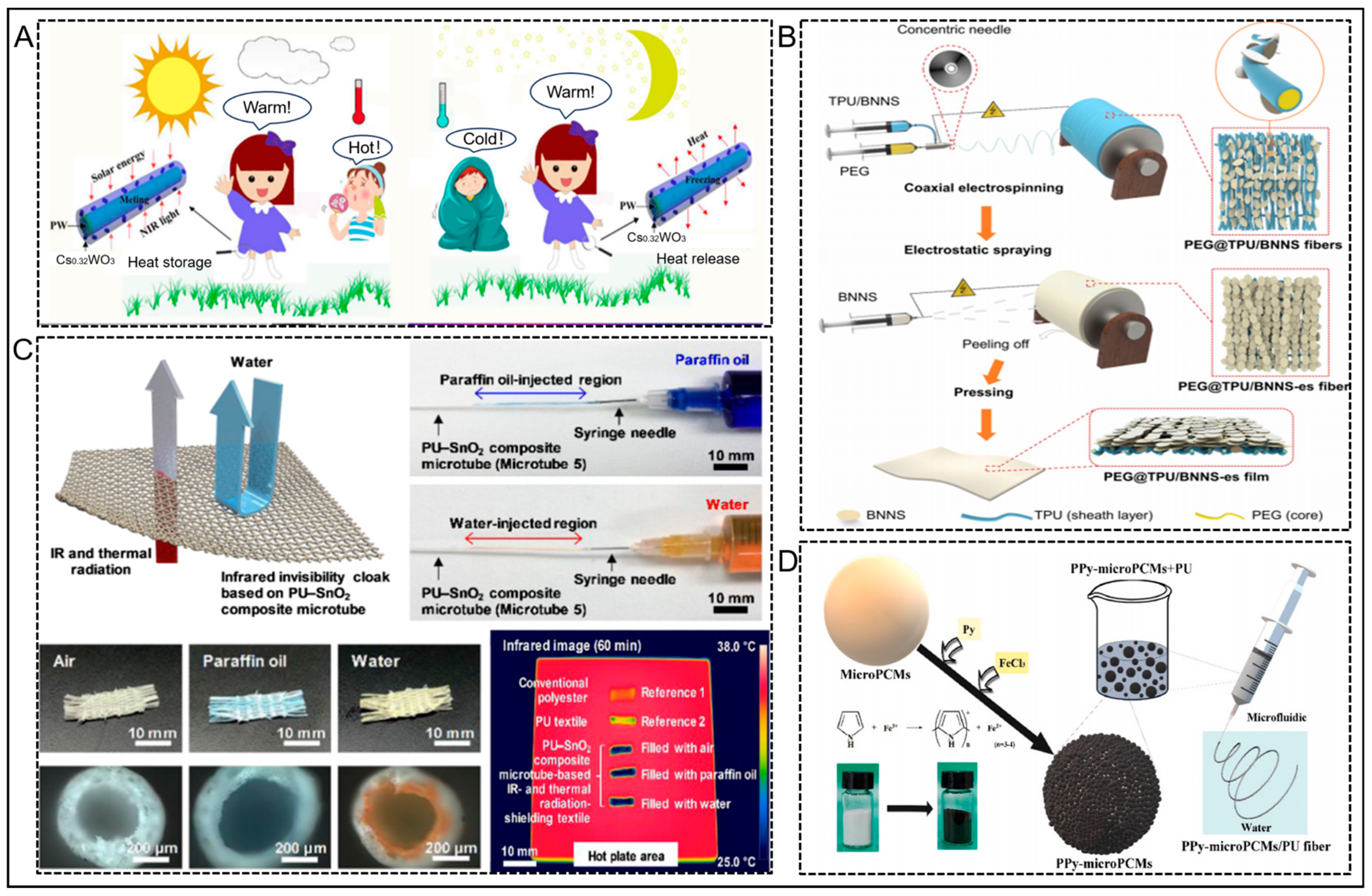
Disclaimer/Publisher’s Note: The statements, opinions and data contained in all publications are solely those of the individual author(s) and contributor(s) and not of MDPI and/or the editor(s). MDPI and/or the editor(s) disclaim responsibility for any injury to people or property resulting from any ideas, methods, instructions or products referred to in the content. |
© 2024 by the authors. Licensee MDPI, Basel, Switzerland. This article is an open access article distributed under the terms and conditions of the Creative Commons Attribution (CC BY) license (https://creativecommons.org/licenses/by/4.0/).
Share and Cite
Sun, Z.; Yu, H.; Feng, Y.; Feng, W. Application and Development of Smart Thermally Conductive Fiber Materials. Nanomaterials 2024, 14, 154. https://doi.org/10.3390/nano14020154
Sun Z, Yu H, Feng Y, Feng W. Application and Development of Smart Thermally Conductive Fiber Materials. Nanomaterials. 2024; 14(2):154. https://doi.org/10.3390/nano14020154
Chicago/Turabian StyleSun, Zhan, Huitao Yu, Yiyu Feng, and Wei Feng. 2024. "Application and Development of Smart Thermally Conductive Fiber Materials" Nanomaterials 14, no. 2: 154. https://doi.org/10.3390/nano14020154
APA StyleSun, Z., Yu, H., Feng, Y., & Feng, W. (2024). Application and Development of Smart Thermally Conductive Fiber Materials. Nanomaterials, 14(2), 154. https://doi.org/10.3390/nano14020154





